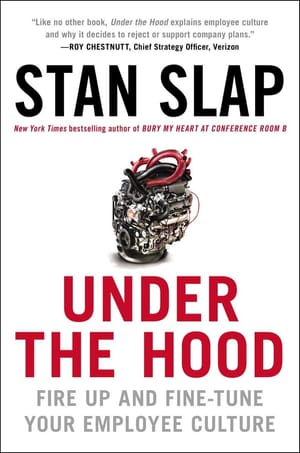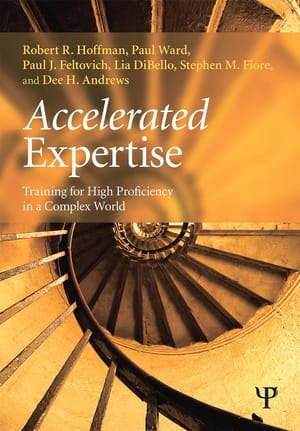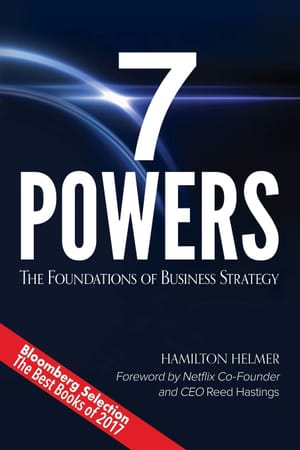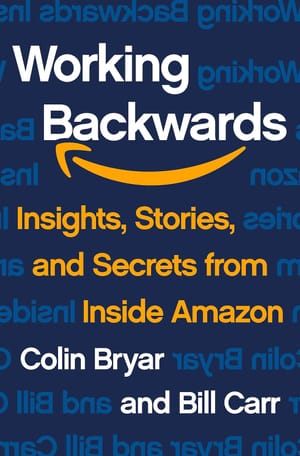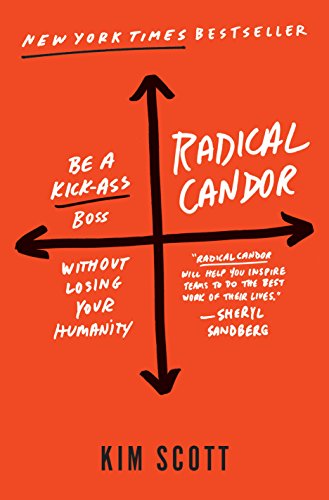
This is a summary of a good 🌿 branch book. This is not a comprehensive summary, so you should still purchase the book if you’d like to implement the low-level tactics Scott has to recommend. Read more about book classifications here.
Radical Candor by Kim Scott is a wonderful 2017 book about ‘being a kick-ass boss’ — boss here being the term Scott prefers to use when talking about managers and leaders.
So who is Kim Scott?
Scott led AdSense, YouTube, and DoubleClick Online Sales & Ops at Google, and then joined Apple University to develop and teach a leadership course. She then spent some time as CEO coach at Dropbox, Qualtrics, Twitter and a whole bunch of other tech companies. The ideas in Radical Candor draw from her experience running large teams in the tech industry (or coaching the people who do!); she's fairly well known in Silicon Valley. Scott is very believable.
While Scott includes a boat-load of tactical advice in her book, I’m going to leave those out of this summary in favour of what I see as her primary contributions to the canon of management writing. It’s probably worth it to buy a copy of this book for these tactical ideas if you’re currently a practicing manager — as an example of just one of them, Scott gives a list of possible approaches if you’re a boss who hates crying, and you find yourself dealing with a subordinate who cries a lot. (Answer: walk out of your office to get tissues, giving your subordinate some time to compose themselves; keep a stash of unopened bottled water on hand and give one to them; the act of drinking will allow them to recover).
The book is chock-full of handy little tactics like this. But I digress.
I think there are three main contributions in Radical Candor, contributions that I haven’t seen anywhere else:
- The description of ‘radical candor’ — what it looks like, what it isn’t, how to start practicing it, and how to avoid common gotchas.
- Russ Laraway’s recipe for rapidly building trust in a team.
- Scott’s description of ‘superstars’ vs ‘rock stars’ — and what this means when it comes to managing team growth.
We’ll go through these ideas in order.
1. Radical Candor, Obnoxious Aggression, Ruinous Empathy, Manipulative Insincerity
Radical Candor itself is a really simple idea: that is, you may give difficult feedback if the person you’re giving feedback to knows that you care personally for them. This framing is really useful when you’re a manager: one of the most important tasks a manager may do is to give good, actionable feedback to her team; radical candor shows you how to do so without being an asshole.
At some level, we all know this to be true. You’re more likely to accept harsh feedback from a friend, for instance, as compared to a random stranger. But Scott’s formulation of the problem provides some nice levers: she points out that you may now evaluate any piece of feedback along two dimensions — the care personally dimension and the challenge directly dimension. Scoring low on either dimension throws you into one of the lousier quadrants:
- High on ‘Care Personally’, Low on ‘Challenge Directly’ — this is Ruinous Empathy, and it’s what you do when you ‘just want to be nice’. This leads to outcomes like ‘not telling nice-guy Joe from customer support that he treats clients like they’re beneath him, and that he either needs to work on that or get out of this line of work’.
- Low on ‘Care Personally’, Low on ‘Challenge Directly’ — this is Manipulative Insincerity, and it’s what happens when you say things you don’t mean to get someone out of your hair. For instance, Sarah did badly on her sales presentation, but you don’t like Sarah because you’ve judged her to be a terrible person, and so you tell her that she ‘did a good job’ so that you can go back to your own work.
- Low on ‘Care Personally’, High on ‘Challenge Directly’ — this is Obnoxious Aggression, which basically means you’re an asshole. Ironically, Scott notes that Obnoxious Aggression is the only alternative form of feedback after Radical Candor, which explains why sometimes assholes get ahead. They get ahead because they err on the side of actually giving feedback — and honest, actionable feedback is what is needed to deliver performance as a manager!
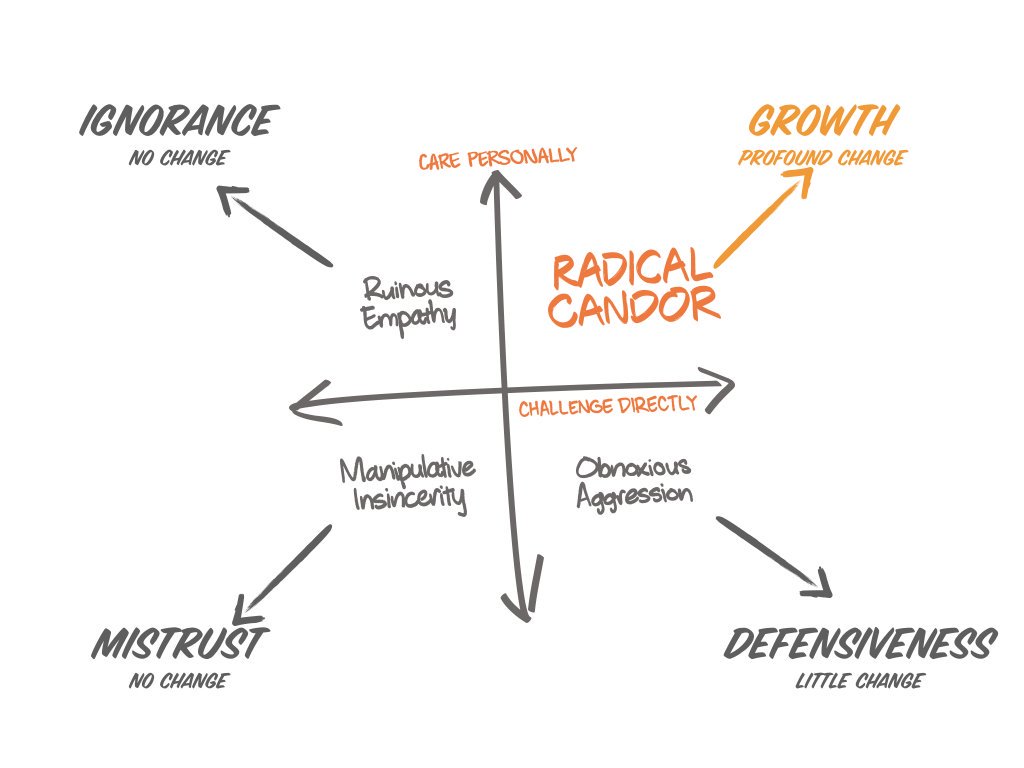
Now that she’s framed things this way, Scott spends a good portion of the book exploring the nuances of this formulation.
The first level of nuance is that ‘care personally’ is measured at the ear of the receiver. This implies that radical candor is both culture and individual specific, and that you need to tailor your approach to the context you’re operating in. Scott tells of her experience working with Israelis — some of the most direct people she’s ever worked with — and contrasts this with the story of working with the AdSense team in Japan, who operated at the other end of the spectrum. Her approach differed very differently for both teams.
The flip side of this, of course, is that you need to tailor your feedback for the person you’re dealing with. You probably know some people who are more likely to read bad intentions into actions than others; Scott argues that because ‘care personally’ is measured at the ear of the receiver, it’s your job as manager to tailor your feedback accordingly. Take the time to explain where you’re coming from. Listen carefully to ensure your feedback isn’t received the wrong way.
The second nuance is that radical candor can apply to both criticism and praise alike! Scott’s recommended approach is to start with praise first, and to do it with your subordinates (not your boss!) This allows them to get used to the idea of radically candid feedback, in a way that is both easier for them and for you. The other rule of thumb that Scott suggests is to solicit radically candid criticism from your subordinates before you start dishing it out. That way you demonstrate that you can take it before you start giving it.
In order to receive radically candid criticism from an unwilling team, Scott suggests that you spend a couple of weeks doing the following:
- Don’t let people off the hook when they refuse to give feedback. Keep asking, and then use silence to get them to say something.
- Reward them handsomely for their criticism. Thank them, praise them, most importantly: take action to fix their criticism if you can.
- Scott argues that you should be soliciting guidance every day, in one-to-two minute conversations between engagements, not in scheduled meetings on your calendar. (To drive this point home, Scott tells the story of Sheryl Sandberg actively chasing a banker for feedback — during Facebook’s IPO process! Sandberg was relentless in her desire for improvement).
Once you’re ready to start giving radically candid criticism, however, Scott recommends explaining to your team the concept of radical candor, and to put up a board with the four quadrants on your desk. After every instance of giving feedback, get your subordinates to tack on a sticky note in one of the four quadrants, as feedback on how well you did. This should prompt you to improve rather rapidly!
I really enjoyed Scott’s formulation of radical candor, as it describes what I had long observed to be true in my practice. I’ve mentioned before that I had been using radical candor before reading the book, mostly by accident (I used to say “giving a shit makes my people problems tractable”) but Scott’s book described this idea at a level of detail that I did not have.
For instance, one obvious implication of ‘radical candor’ is that the primary challenge for a manager working with a new team, or working with a new hire, is to quickly ramp up on the ‘care personally’ dimension, in order to deliver challenging feedback. The quicker you can ramp up on ‘care personally’, the quicker you can give guidance and drive results without being an asshole. This is only clear if you see feedback as having two dimensions.
Scott’s stories, peppered throughout the book, also highlight important deficiencies between my practice as a manager and the practices of the best managers in the tech industry. I was struck by Scott and Sandberg’s desire for constant criticism from their teams, to a degree that I’d not done with mine. I was also struck by the habit of impromptu guidance that Scott says she’s experienced in the highest levels of tech leadership — I tend to keep my feedback to scheduled meetings and regular one-on-ones; Scott and Sandberg and Costolo (then-CEO of Twitter) would give feedback in between scheduled engagements — sometimes while walking to the next meeting!
The challenge of ramping up quickly on the ‘care personally’ dimension leads us to the next big idea:
2. Russ Laraway’s Recipe for Rapidly Building Trust with a Team
Russ Laraway was the co-founder of Candor, Inc with Kim Scott. In the book, Scott describes a technique Laraway developed to rapidly build trust with a new team — a technique he needed when he had to integrate DoubleClick’s people into Google, post-acquisition.
The technique is called ‘Career Conversations’, and it goes like this:
First, Career Conversations should be done infrequently. My impression of Laraway’s technique is that they should only be done at the beginning of your relationship with your subordinate. These conversations are going to take a lot of time — so it’s probably not something you can keep up over the long term.
You’re going to be scheduling a number of one-on-one meetings with your reports. Ensure that each meeting is at least an hour long. However, unlike your normal one-on-ones, you’ll be doing these meetings explicitly for the purpose of Career Conversations.
In the first session, you’ll ask your subordinate to tell you about their lives. Laraway suggests “Starting with kindergarten, tell me about your life.”; I’ve found “Tell me about your hometown” to be an equivalent opener in Vietnam.
The goal here is to learn what motivates each person who reports directly to you. Once you’ve got the conversation started, focus on changes that people have made and understand why they’d made those choices. A person’s value system often gets revealed in moments of change in their lives. For instance, “I quit my job at Wall Street” could mean “I quit banking because I thought it made the world a worse place” or it could mean “I didn’t like the long hours.” Your goal is to understand your people as individuals, through their stories.
Laraway warns against pushing too hard:
If a person signals discomfort at a question, you have to respect that. For example, one person seemed profoundly uncomfortable with some basic questions about childhood. Sensing this, Russ let childhood drop, and the woman went on to describe her life after grad school, becoming much more confident. As he got to know her better, Russ learned that she’d had some significant trauma growing up. But she hadn’t been comfortable telling Russ about it during a get-to-know-you conversation, and Russ hadn’t pressed.
Once you’ve concluded the first conversation, the next meeting will move from understanding people to understanding their dreams. Laraway opens this conversation with “What do you imagine the pinnacle of your career to look like?”
The way you ask this question matters a whole lot. Most people are used to managers asking for “career aspirations”, “long term goals” or “five-year plans”. These questions invoke cliched answers: typically, an experienced person will know to say “I want to be like you” (sufficiently ambitious) “but I don’t want your job” (yet not too ambitious).
Your goal here isn’t to get a cliched response, or even a career aspiration in the context of your company and its promotion system. Laraway asks for dreams — crazy-ass dreams, and he encourages his reports to come up with three to five different dreams for the future. This could be as diverse as “starting a spirulina farm” or “achieve financial freedom to take care of my family”.
After this second conversation, have your reports create a document with three to five columns: title each with the names of the dreams they described, and then list the skills needed as rows. Work with them to organise each skill in importance to each dream, and talk to them about how competent they are in each skill. Generally, it should become obvious what new skills the person needs to acquire. As a final step, help them think about how you can assist them in their pursuit of acquiring these goals in your team: what projects can you put them on, whom can you introduce them to, what courses can they sign up for?
The last part of conversation two is to link this with your previous conversation:
The final part of Russ’s second conversation involves making sure that the person’s dreams are aligned with the values they have expressed. For example, “If ‘hard work’ is a core value, why is one of your dreams to retire early?” Inquiring about the dreams people describe is an important way to push for candid, meaningful conversations. In one instance at Google, Russ’s question revealed that the person had a special-needs child whose condition was expected to become especially acute in the teenage years. This father wanted to make sure he would be able to focus his entire attention on his child when the child was likely to need him most. That put his plans for early retirement in a whole different light.
Your third conversation is to come up with an 18-month plan. This should be easy given the groundwork laid out in your first and second conversations. But Laraway teaches his managers to get their people to ask themselves the following questions:
“What do I need to learn in order to move in the direction of my dreams? How should I prioritize the things I need to learn? Whom can I learn from?” How can I change my role to learn it? Once people were clear on what they wanted to learn next, it was much easier for managers to identify opportunities at work that would help them develop skills in the next six to eighteen months that would take them in the direction of at least one of their dreams.
Why does this matter? Well, a translation of current work to future dreams is far more inspiring for people than “Here’s how you climb the next rung on the corporate ladder.
(Bonus: here’s a First Round Review post on Laraway’s Career Conversations Technique.)
3. Rock Stars vs Superstars
The final idea I find significant in Radical Candor is Scott’s observation that there are two kinds of people in a team: rock stars, who are ‘solid like a rock’, and superstars, who are on a steep career trajectory. The former form the backbone of your team; the latter are people who you’d be lucky to hold on to for long.
Scott uses the following illustration to explain what she means:
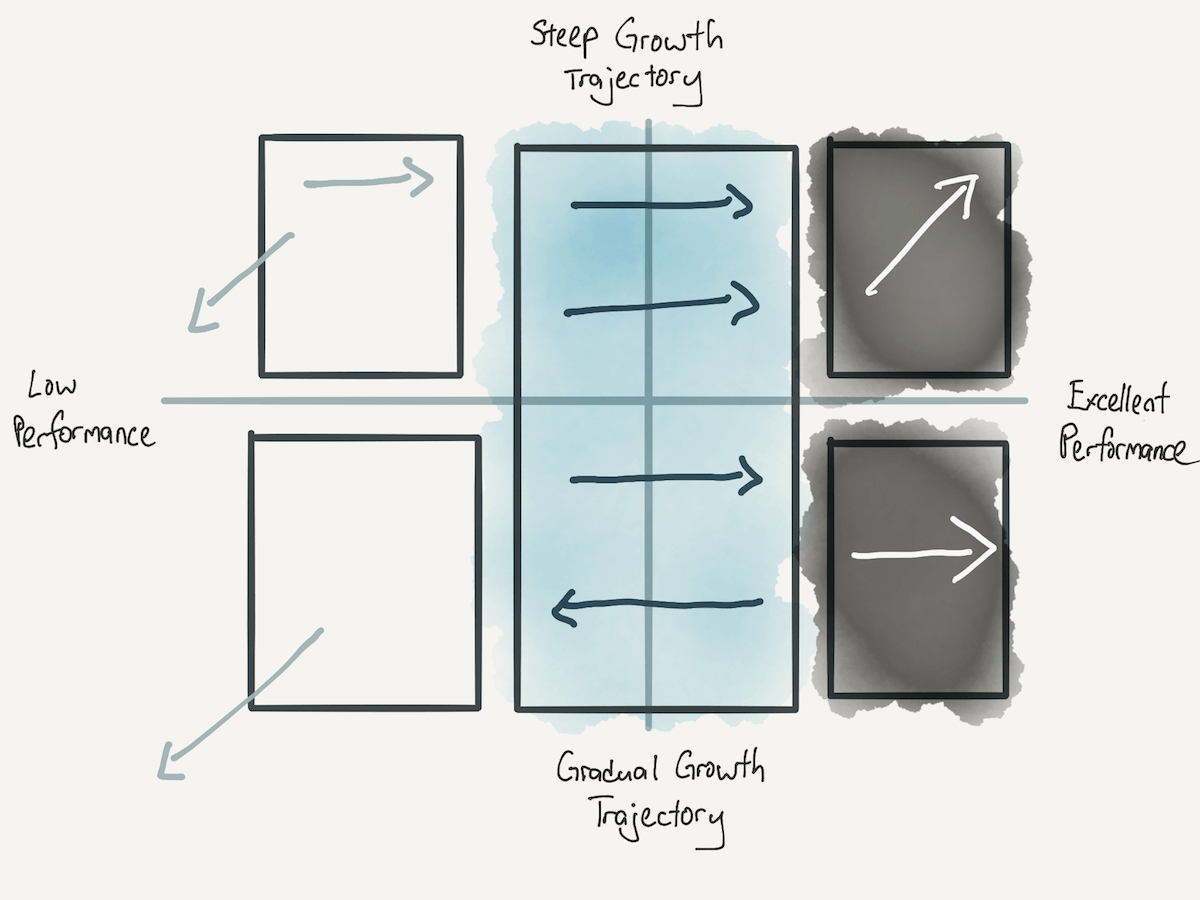
The implication of this illustration is that only excellent performance matters; as a manager, your job is to push people until they hit peak performance (left to right movement). But once they’ve hit that level of performance, you should find ways to reward good performers regardless of their growth trajectories.
There are a number of subtle things going on with this idea, and Scott takes an entire chapter (Chapter 3, if you’re wondering) to unpack the assumptions in this model.
The first level of nuance is that there is a difference between judging based on potential and judging based on growth. The differences matter: Apple’s Scott Forstall challenged Kim Scott’s original version of this model — which used ‘potential’ on the vertical axis. Forstall argued that ‘instead of evaluating a person according to potential (which leaves room for bias!), managers should evaluate according to their current growth. This enables managers to ask questions like “what growth trajectory does each person on my team want to be on right now?” and “have I given everybody opportunities that are in line with what they really want?”’
Evaluating people based on their potential comes with a number of problems. First, you risk losing quality people who have no desire for a steep growth trajectory. Scott notes that growth trajectory is temporal, not innate: she gives a couple of examples:
- When Scott was trying to have children, she scaled back her ambitions for a number of years. She could do this because she was at Google in a senior role. Rewarding based on potential would have severely harmed her earlier in her career!
- Scott also talks about a couple of subordinates who were Olympians; after their retirement as athletes, they threw themselves into their careers, and rose swiftly.
If this wasn’t bad enough, Scott talks about how promotion ruins otherwise excellent rock stars. We’ve all heard of the Peter Principle — where people rise to their level of incompetence. It turns out that if you don’t have a method of rewarding excellent performers on a slower growth trajectory, you will find yourself consistently using promotions as a tool to elevate good performers beyond their preferences — and out of their performance.
Third — and I found this most important given my background in smaller companies — optimising for hires with steep growth trajectories implies that you’ll only be able to hold on to them for a limited period of time. Eventually, the growth of the superstar might outstrip your team, and you’ll experience turnover. This might not matter for high-growth companies, but if you’re in a larger company, or a slower-growing one, you probably shouldn’t expect high-growth employees to stick around for very long. This is why it’s probably important to have a mix of ‘superstars and rock stars’ on your team at any given time.
Scott explains that there’s a bias for superstar team members in Silicon Valley, and that for many years she fell prey to this belief. (My friends in big tech tell me this culture still exists; Facebook has an unofficial ‘up or out’ policy.) I was surprised when I learnt that Apple stood apart on this issue; Scott describes how Apple rewards 10-year employees with a beautiful, sandblasted glass sculpture, a unique way of rewarding stable-growth employees. She also tells of how Steve Jobs took retention very seriously, and talked warmly of those who had spent a long tenure at Apple.
So how do you reward rock stars? Scott recommends a number of methods, all of which are built around the idea of recognising them for their expertise and contribution without promoting them:
- Give them bonuses, or raises.
- Create formal teaching and mentorship roles, and move them into these roles. Scott notes that Apple rewards rock stars with respect and recognition, and deploys its rock stars to help new people level up faster. The culture is starkly different from other big tech companies: in Google, for instance, being in the same role for too long was a badge of shame.
- If they are shy, find methods to personally thank them and recognise them for their contributions.
- Don’t overlook rock stars on a stable growth trajectory in your rating system. The rating system should reward performance, not potential or growth. It’s often too easy to grade rock stars lower than superstars.
- Figure out which growth trajectory your subordinates want to be on, and regularly check in on them in case they decide to switch.
Fin
I find Radical Candor an excellent book, filled with actionable ideas and pragmatic tactics that Scott has deployed throughout her life. The only criticism I have of it is that Radical Candor is better suited for good managers who want to become great; many of the higher-level tactics that Scott suggests aren’t very useful to the new manager who hasn’t yet figured out delegation, training, prioritisation and one-on-ones.
I’ve come to see the book as a good counter-point to High Output Management’s focus on the procedural side of management. Where HOM focuses on process, Radical Candor focuses on people. You need both to be good at management.
Originally published , last updated .
This article is part of the Operations topic cluster, which belongs to the Business Expertise Triad. Read more from this topic here→

